Passengers 133 Injuries (non-fatal) 112 (12 serious) Date 7 March 2007 Passenger count 133 | Fatalities 21 Survivors 119 Number of deaths 21 Survivor 119 Crew count 7 | |
 | ||
Site Adisucipto International Airport (IATA: JOG; ICAO: WARJ) Similar Adam Air Flight 574, British Airtours Flight 28M, United Express Flight 5925, Crossair Flight 3597, Air Moorea Flight 1121 | ||
Garuda Indonesia Flight 200 (GA200/GIA 200) was a scheduled domestic passenger flight of a Boeing 737-400 operated by Garuda Indonesia between Jakarta and Yogyakarta, Indonesia. The aircraft overran the runway, crashed into a rice field and burst into flames while landing at Adisucipto International Airport on 7 March 2007. Twenty passengers and one crew member were killed. Both the captain and the first officer survived.
Contents
- Aircraft
- Garuda Indonesia
- Flight chronology
- Aftermath
- Investigation
- Report of the NTSC
- Prosecution of the captain
- In popular culture
- References
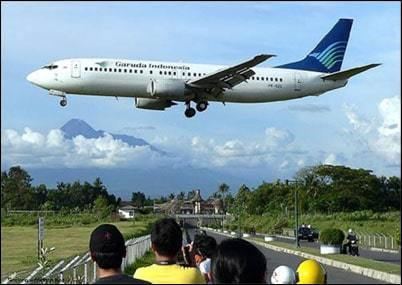
Aircraft
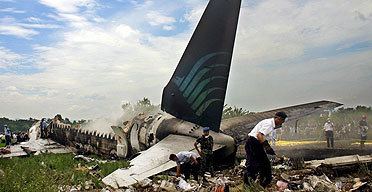
The aircraft was a Boeing 737-497, registered as PK-GZC, which had been operated by other airlines before being acquired by Garuda Indonesia. The aircraft had accumulated a total of 35,157 airframe hours and 37,328 cycles since its first flight on 5 November 1992.
Garuda Indonesia
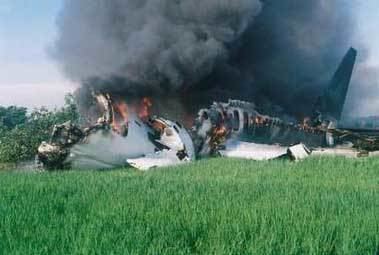
The oldest airline in Indonesia (founded in 1949), Garuda Indonesia had received a number of criticisms in the months surrounding the crash. According to Australian aviation experts, Garuda Indonesia had one of the worst safety records among the world's national carriers. Since 1950, Garuda Indonesia has had 13 major accidents. The most recent was in 2002, when Garuda Indonesia Flight 421 ditched in the Bengawan Solo River due to engine flameout caused by excessive hail ingestion, killing a flight attendant. The worst accident was in 1997, when Garuda Indonesia Flight 152 flew into a wooded mountain on approach to Medan, killing 234 people. The managing director of the Centre for Asia Pacific Aviation, Peter Harbison, stated that the major accidents in Indonesian aviation history were all caused by the combinations of airports' and fleets' low safety standards and the poor weather conditions in the area, including severe thunderstorms and other forms of inclement weather.
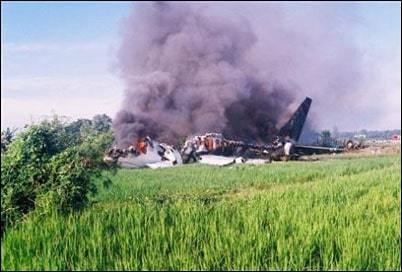
Following the crash of Flight 200, the European Union banned Garuda and all Indonesian airlines from flying into the EU. The ban was a watershed for Garuda, leading to widespread reforms within the airline to improve both its safety and service standards, and led to the implementation of the 5-year Quantum Leap program, which nearly doubled its fleet, introduced new aircraft such as the Boeing 737-800 and Boeing 777-300ER, and also connected more destinations, with the airline starting or resuming service to destinations such as Amsterdam and London. The European ban on Garuda was lifted in June 2009, and the airline is now a 5 star rated airline by Skytrax, and has had an excellent safety record since the reform began.
Flight chronology
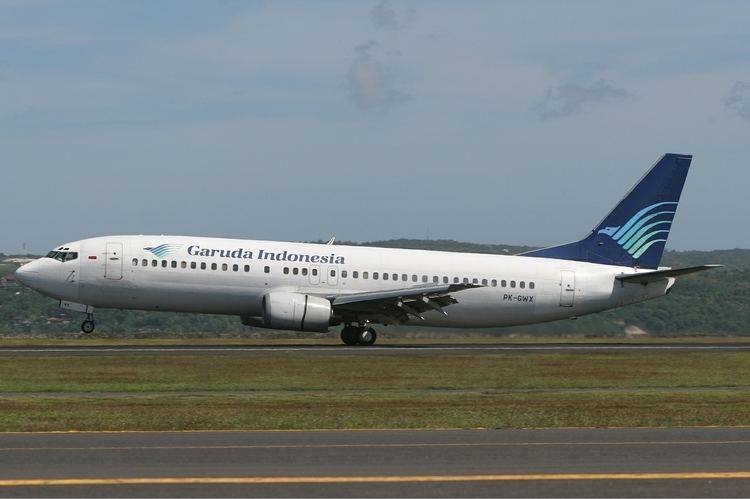
Flight GA200 originated in Jakarta and was carrying 133 passengers, 19 of whom were foreigners. Several Australian journalists were on the flight, covering the visit of Foreign Affairs Minister Alexander Downer and Attorney-General Philip Ruddock to Java. They were on the flight as the aircraft carrying Australian dignitaries were at capacity.
At 6:58am local time (UTC+7), the captain attempted to land at Adisucipto International Airport in Yogyakarta, despite a faulty approach with excess speed and steep descent, and the resulting warnings of copilot and flight system. The aircraft touched down 860m beyond the runway threshold at a speed of 221kt, 87kt faster than the normal landing speed. According to passengers, the aircraft shook violently before it crashed. The aircraft overran the end of the runway, went through the perimeter fence, was heavily damaged when it crossed a road, and stopped in a nearby rice field. A fuel-fed fire raged, which could not be reached by airport fire-suppression vehicles. While most passengers were able to escape, a number of passengers perished inside the burning fuselage.
The pilot, Captain Muhammad Marwoto Komar, initially claimed that there was a sudden downdraft immediately before the flight landed, and that the flaps on the aircraft may have malfunctioned.
Aftermath
One of the passengers was a cameraman for the Australian Seven Network. He escaped from the burning wreckage with his camera and started recording the aftermath. He made a telephone call to inform the network's Sydney newsroom and the footage was beamed back to appear on the 6pm news of that night. Two Australian Federal Police agents, Australian Embassy staffers Liz O'Neill (public relations officer) and Allison Sudradjat (Minister Counsellor and Senior Representative of AusAID), and Australian Financial Review newspaper journalist Morgan Mellish were among those killed.
Investigation
The accident was investigated by the Indonesian National Transportation Safety Committee (NTSC). Australian Federal Police disaster victim identification experts were deployed to the scene to assist with the identification of bodies. Australian Transport Safety Bureau (ATSB) staff assisted at the scene by inspecting the wreckage. The United States' National Transportation Safety Board (NTSB) dispatched a team to assist in the investigation, including representatives from Boeing and the Federal Aviation Administration. The flight recorders (flight data recorder and cockpit voice recorder) were removed from the wreckage and flown to the ATSB's headquarters for further analysis using equipment not yet available in Indonesia. Staff in Australia could not extract data from the cockpit voice recorder, which was then sent to the Boeing factory in the United States to be analysed.
Report of the NTSC
After the crew members were interviewed, the wreckage was examined, flight data and cockpit voice recordings were analyzed, and a safety review of the airport was conducted, Indonesia's National Transportation Safety Committee released its final report on 22 October 2007. No evidence was found of any defect or malfunction of the aircraft or its systems that could have contributed to the accident. Records showed only the right thrust reverser had been used for the previous 27 sectors, but a fault condition for the left reverser was reset by engineers before departure for this flight, and both were deployed during the landing roll. The weather was calm. It was noted that the Yogyakarta Airport did not conform to international safety standards, having a runway runoff 60 metres in length, compared to the recommended length of 90 metres.
The key NTSC finding is that the aircraft was flown by the Pilot in Command (PIC) at an excessively steep descent and high airspeed (241 kts rather than the normal 141 kts) during the approach and landing, resulting in unstable flight. The PIC's attention became fixated on trying to make the first approach work, and he failed to heed the warnings of the copilot and his recommendations to abort the landing and go around, and the repeated warnings from the aircraft flight systems, which were audible in the voice recorder data, e.g. "Sink rate" and ‘Whoop whoop, pull up". The copilot failed to take control of the aircraft in these extraordinary circumstances, as required by airline policy, apparently due to inadequate training. Wing flaps were not fully extended to the maximum 40°, not even to the 15° repeatedly requested by the captain, but only to 5° because the copilot was aware that this was the recommended maximum for that high airspeed, but he failed to notify the captain.
The touchdown, followed by two bounces, began 240 m beyond the nominal touchdown zone. The nose landing gear was severely damaged and broke apart during the following roll. The main engine thrust reversers were deployed 4 seconds after the touchdown, continued for 7 seconds, but were stowed 7 seconds before the aircraft left the end of the paved runway and ploughed through the airport perimeter fence. About 160 meters beyond the end of the runway, the aircraft crossed a small ditch and adjacent road that is 1−2 m below the level of both the runaway and the rice paddy on the far side. The nose of the aircraft impacted the roadside embankment and the engines impacted the concrete curb just before that embankment. The aircraft came to rest in the rice paddy field 252 meters beyond the runway. It was severely damaged by the impact forces, leading to an intense, fuel-fed fire Airport fire-control vehicles were unable to reach the crash site through the ruptured fence because of the slope and ditch between there and the road. The firemen were unable to deliver sufficient fire suppression foam on the burning aircraft because the hose that they dragged across the road became punctured by rescue vehicles and onlookers’ vehicles driving over it and sharp objects such as the damaged fence. About 45 minutes after the crash, two city fire fighting vehicles arrived and were ordered by an un-qualified person to start hosing the fire with water. The fire was extinguished about 2 hours and 10 minutes after the crash. Coordination and procedures during the rescue were not in accordance with the Airport Emergency Plan (AEP) manual, and lacked coherence.
In summary, the NTSC Report attributed the accident to pilot error.
As of March 1, 2007, Garuda Indonesia had implemented a new fuel efficiency incentive, which would award a salary bonus if fuel consumption for a flight was lower than nominal. During his interview with the NTSC, the captain denied that this had influenced his decision not to abort the landing.
Prosecution of the captain
On 4 February 2008 the captain, Marwoto Komar, was arrested and charged with six counts of manslaughter. The charge carried a penalty up to life imprisonment if the court found the crash was deliberate. Short of that finding, the lesser charge of negligent flying causing death carries a maximum sentence of seven years. The copilot testified that he had told the captain to go around because of excessive speed, and that he then had blacked out due to the severe buffeting. On 6 April 2009, the captain was found guilty of negligence and sentenced to 2 years in jail. The captain's lawyers stated their intention to appeal on the basis that the Convention on International Civil Aviation, to which Indonesia is a party, stipulates that aviation accident investigation reports cannot be used to ascribe blame, but only to determine cause. The Garuda Pilot's Association and Indonesian Pilots Federation threatened to strike in protest against the conviction. On 29 September 2009, the conviction was quashed by the Indonesian High Court, which found that the prosecutors had failed to prove that the pilot was “officially and convincingly guilty of a crime”. This case was later cited in a report published by the American Bar Association, in a defence of the principle that airline safety is undermined by such prosecutions because the threat of them taking place would impede the investigative processes.
In popular culture
The crash is featured in the Season 15 premiere of Mayday (Air Crash Investigations). The episode is titled "Fatal Focus".
